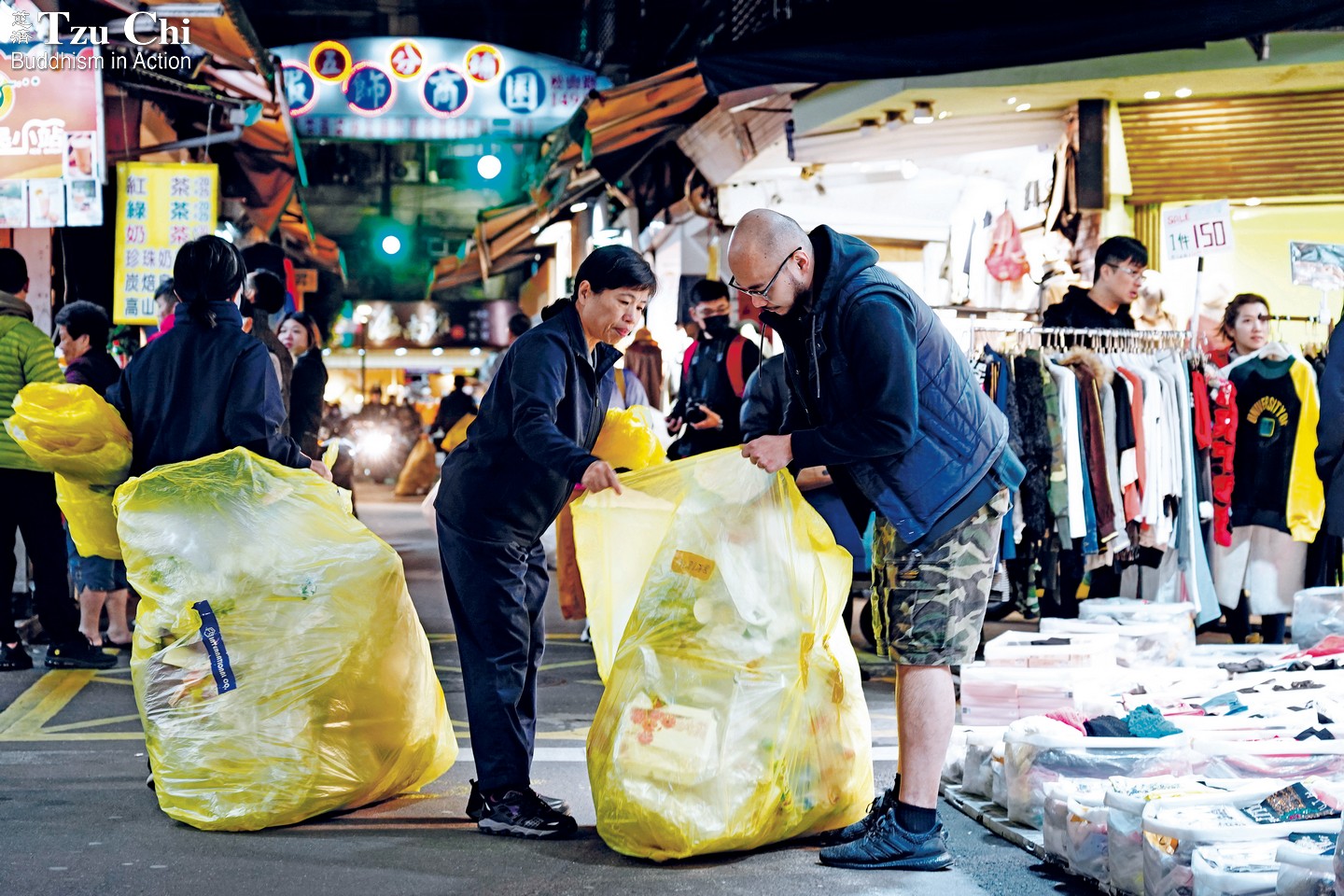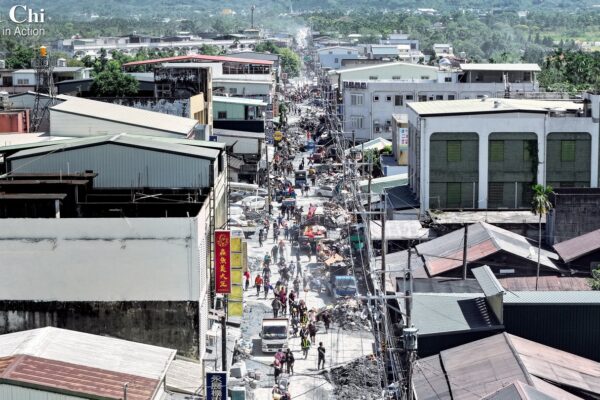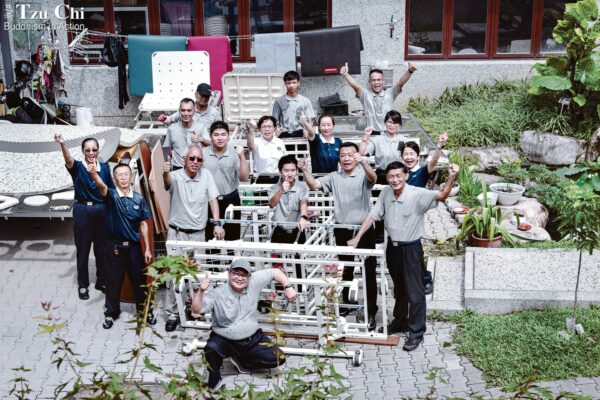By Chen Li-an
Translated by Wu Hsiao-ting
Photos by Hsiao Yiu-hwa
More than 15 billion plastic bags are used in Taiwan every year, but less than ten percent are recycled. Sorting and preparing plastic bags for recycling is time-consuming, and the resulting profits are paper thin. Even scavengers have no interest in them.
People work inside a factory which converts used plastic bags into raw materials in the form of plastic pellets. INSET PHOTO BY CHEN LI-AN
Housewives shop for their families amidst the typical hubbub of a market. They weave among stalls that sell an assortment of goods—clothing, pre-cooked food, fresh fruit, almost anything you could want. Vendors are more than happy to proficiently bag their purchases before turning their attention to the next customer. By the time shoppers leave the market, they are loaded with all kinds of sundry items—and all the plastic bags used to carry their purchases home.
Plastic bags are lightweight, durable, and easy to carry, making them extremely convenient to use. Unfortunately, convenience often comes with a cost.
Raining plastic particles
According to statistics published by Taiwan’s Environmental Protection Administration in 2019, the number of plastic bags used in Taiwan decreased from 18 billion to 15 billion per year. The decrease happened after two government restrictions on the use of plastics were announced. Despite the noticeable reduction, however, the recycling rate of plastic bags is pitifully low—less than ten percent. That level is about the same the world over. Of the hundreds of millions of tons of plastic waste produced globally every year, only nine percent is recycled. Twelve percent is incinerated, and the rest is landfilled or left littering the environment.
We forget about a piece of garbage as soon as we throw it away. It’s a case of “out of sight, out of mind.” But discarded plastics do not simply disappear into the environment. Though they are eventually broken down into smaller particles of plastic, they are not biodegradable. In 2019, American scientists discovered microscopic pieces of plastic of various colors in rainwater. This discovery is not an isolated incident. Scientists have also recorded a daily rate of 365 microplastic particles per square meter falling from the sky in the Pyrenees Mountains in the south of France.
Plastic pollution has, no doubt, become a pressing environmental issue in today’s world. Surprisingly, plastic bags—one of the most widely used plastic products—were invented to “save the planet.” Sten Gustaf Thulin (1914—2006), a Swedish engineer, created plastic bags about 60 years ago as an alternative to paper bags, which were considered bad for the environment because their production involves the chopping down of trees. Plastic bags went into mass production a few years later. The popularity of all sorts of plastic packaging soon followed.
Raoul Thulin, son of the inventor, said that his father believed that plastic bags, being durable, would be used repeatedly instead of just once. This, sadly, has not happened. Though created with noble intentions, the now ubiquitous plastic bags have become an environmental dilemma as they contribute to a serious pollution problem around the world.
A labor of love
At the Shuanghe Recycling Station in New Taipei City, northern Taiwan, volunteers work diligently with recyclable garbage in various sorting areas. Among them is a group of people dexterously working through a small mountain of plastic bags. Picking a bag from the mountain, they classify it as one of four types: clear polyethylene (PE), colored PE, clear polypropylene (PP), or colored PP.
“This soft material is PE,” said volunteer Wu Li-mei (吳麗美), who has sorted and processed plastic bags for more than ten years. She pulled a red and white striped bag from the pile and explained that the plastic, soft-to-the-touch and flexible, is PE. Fruit wrappers often seen at fruit stands in Taiwan are, for example, usually made of PE.
Wu next picked out a large, transparent plastic bag from another pile and said, “This one was used to package clothes. It makes a crackling sound when you touch it, and it’s harder to stretch. It is made of PP.”
PP and PE are the two most common recyclable plastic bag materials. They do not contain toxic substances such as chlorine, and are therefore safer to recycle.
“The first step in learning to sort plastic bags for recycling is to be able to tell the difference between PP and PE,” Wu explained. Plastic bags come in all kinds of designs, she added, and it can be confusing for newbies to tell what material a bag is made of. They usually teach new volunteers to feel whether a material is soft, flexible, etc. to decide whether it is PP or PE.
After the plastic bags are sorted into the four categories, volunteers further process them by removing foreign objects or undesirable parts from them. Volunteers Lin Xiu-chou (林秀綢) and Xie Su-zhen (謝素真) emphasized that some bags come with sticker labels or sealing adhesive, and that because different materials have different melting points, those foreign parts need to be cut off so that they won’t damage the recycling machines when the bags are being processed into raw materials.
Countless plastic bags are sent to Tzu Chi recycling stations across Taiwan every day. They come from shops, factories, or community collection points. If the bags that end up in a recycling station are stained or greasy, they are first washed with recycled rainwater, then sun-dried before further sorting and processing. Only when the bags have been cleaned and sorted and undesirable substances have been removed will they be sent on to their next stop on their journey of rebirth.
The Tzu Chi recycling stations throughout Taiwan collected and sorted 6,424 metric tons (7,080 tons) of plastic bags in 2019. A monthly average of six metric tons (6.6 tons) is processed at the Shuanghe Recycling Station. About ten volunteers work on plastic bags at the station every day, turning out ten kilograms (22 pounds) of colored PE alone every day. The bags fetch pitifully little money—only three Taiwanese dollars (ten U.S. cents) per kilogram. The low price and time-consuming sorting process make plastic bags one of the least desirable recyclable items on the market. Even scavengers won’t bother with them.
But the volunteers aren’t motivated by profit. What they care about is the damage such bags can do to the environment if they are not recycled. The last thing they want to see is plastic bags lying around, polluting the environment.
For sustainability
In 2002 the Taiwanese government implemented a policy intended to cut back on the use of plastic bags and disposable tableware. The policy was introduced on a more limited scale in July 2002, followed by a second phase of implementation in January 2003. The government further widened the scale of restrictions in 2018, prohibiting stores from providing free plastic bags to customers.
Ding runs a business making raw materials from recycled plastic bags. He has been in this line of work for 30 years. According to his observations, the number of plastic bags recycled over the years has been steady, even though the government has restricted their use. “People in the habit of using plastic bags still use them,” he said.
Ding said that many decades ago, people in Taiwan used to use lotus leaves, banana leaves, ropes woven from plants, and other natural materials to package raw and cooked food in traditional markets. But those days are long gone. Now, even though people are widely aware of the harm plastics do to the environment, they still use bags freely because of their convenience and low cost.
For this article, my photographer and I visited a plastic pellet factory located in an industrial zone in Taoyuan, northern Taiwan. As soon as we walked in, our eyes were greeted by a garbage-bag mountain higher than a single-story building. A pungent odor permeated the air. Wu, the owner of the factory, pointed to some neatly tied up piles of sorted bags and told us that those were from Tzu Chi recycling stations. He said that bags from Tzu Chi are always carefully sorted and washed. The thoughtful preparation that goes into those bags saves his factory a lot of time to process them.
Wu’s factory specializes in recycling PE plastic packaging. The process of converting such plastics to raw materials isn’t complicated. Recycled plastic packaging is first put on conveyor belts, with workers examining the items and doing further screening. Then the plastics are fed into machines where they are shredded, melted, and pelletized for reuse in the manufacture of new plastic products. “Though the plastic pellets we produce are made from used plastic bags, they can be remade into durable plastic products,” Wu explained.
Wu added that the market price of raw materials made from recycled plastics fluctuates with the rise and fall of oil prices, and a lot of manpower and time is required in the recycling process. Even so, it is worth the effort if the tremendous amounts of plastic waste turned out in the world can be reduced—because the pollution caused by the plastic garbage is diminished along with it.
Refuse whenever you can
Nowadays, more and more people are working on how to give used plastic bags a new lease of life. These efforts are not limited to businesses. National Cheng Kung University in Tainan, southern Taiwan, is a good example. Students in the university’s Industrial Design Department once launched an experimental project making discarded plastic bags into trays, pen holders, etc.
The environmental problem caused by plastic bags has existed for a long time, but it is not difficult to tackle. Besides recycling, reducing and refusing are also simple but effective measures to help solve the problem.
Several older volunteers at the Tzu Chi Sanchong Recycling Station in northern Taiwan shared that before they took up recycling, they didn’t know that plastic bags could be recycled. They usually just tossed them in the garbage like everyone else. Now they realize how much harm plastic bags can do to the environment if they are improperly disposed of. That realization led them to change their habit in the way they use plastic bags. They avoid using them if possible, and when they have to use one, they use it as many times as they can.
“My daughter always carries several shopping bags in her purse,” said Xie Su-zhen (謝素真), a volunteer at the Shuanghe Recycling Station. In addition to shopping bags, her daughter also carries food containers when she shops at a traditional market to avoid using disposable items. When she has no choice but to use a plastic bag, she uses it repeatedly until it is torn before she recycles it. “My daughter lives an ecologically friendlier life than me, a recycling volunteer. I’m really learning from her.”
To reduce the damage we are inflicting on the environment and ease the Earth’s burden, we can start by cutting down on our use of seemingly insignificant plastic bags. Refuse, reduce, reuse, and recycle: these are the golden rules to follow if we want to be conscientious citizens of the global village, leave behind a smaller carbon footprint, and give the planet more breathing room.

Volunteers from the Tzu Chi Sanchong Recycling Station make weekly visits to Wufenpu, an area in Taipei with many wholesale clothing shops, to collect used plastic bags. A large amount of plastic packaging is produced there every day.



